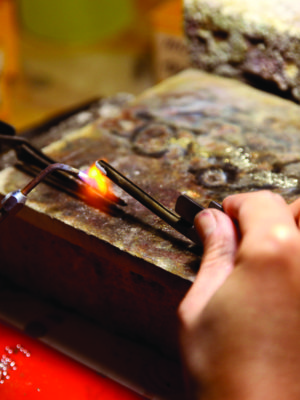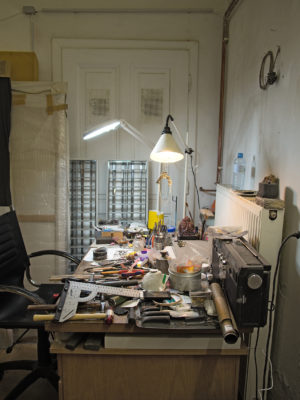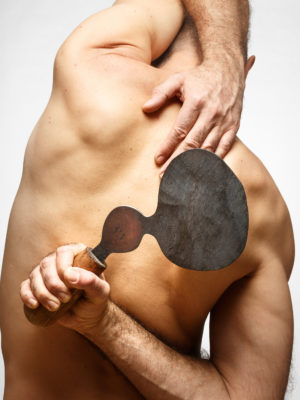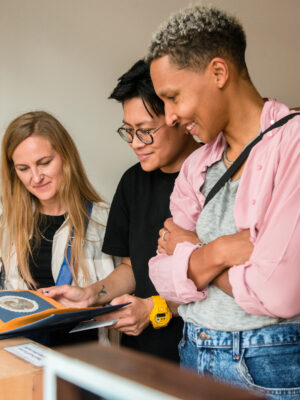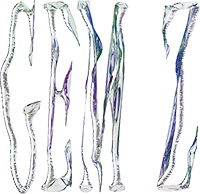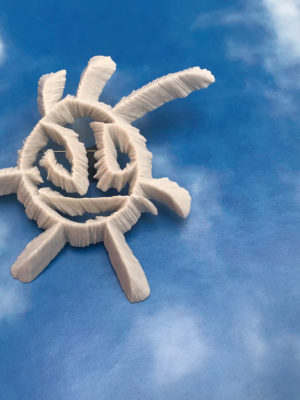
SIMON MARSIGLIA (SM): Recently I have been working with how we present ourselves online and I have ended up slipping into the world of fiction. I think fiction provides a levelling element when it comes to looking at jewellery and art in general, meaning that it makes for a common starting point: everyone has had a fairy tale read to them at some point. It’s a tool that can be used to create your own context for a piece of jewellery, even when it is presented in a white cube gallery. Instead of pushing a complex concept onto the viewer, you can give a suggestion in the shape of a story. I think there are a lot of similarities between the things I make and props for movies.
ALEXANDER BLANK (AB): Do you first write or first make the pieces? Or do they go hand in hand?
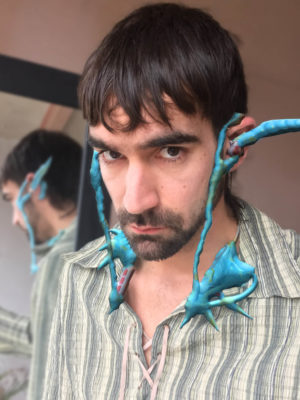
SM: For now I start with the writing. The only restriction I use is the time period. I could probably sit for weeks thinking about the concept for an object. But if I put a shorter time limit on it and just try to write a story – in order to produce something I have to fully immerse myself in the fiction, almost as if I am experiencing it as one of the characters. I think the writing also works as a sort of a decoy, so you are actually fooling yourself into creating objects rather than forcing it. Objects seem to appear more naturally because they appear within the environment of the fiction.
AB: What I personally like about fiction is that it gives a simple way of weaving in a lot of content from different sources (nonsense, theory, gossip, autobiographical stuff, fantasy, critique, whatever), and it creates a more accessible way of looking into an artist’s mindset, compared to being confronted with tough artist statements that sometimes seem too rejecting or narrow things down so that the pieces cannot hold the statements’ ambitions. Narrative is more open to me and for the pieces, and can, of course, be an art-piece itself; it’s fluid, it can change. One can add, include, rewrite, take it from another perspective – and that´s a great possibility. In my own practice a narrative, like a fable, seemed obvious since the work itself is quite figurative. You can find a YouTube video, Blank Tales, where my pieces talk to each other.
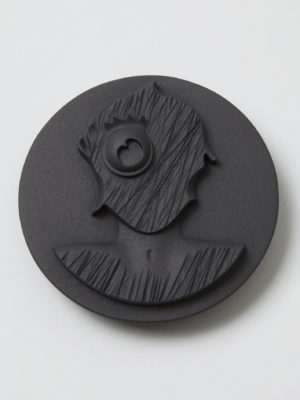
SM: I like the idea of letting the objects build a narrative, but here you had the objects first, and then came fiction? Or did you plan it all from the beginning?
AB: The first object came more or less without a story, but with further pieces it developed more and more into a fiction. This was very joyful and it gave me a way to play and narrate like a kid. It grew into the process organically. I believe that jewellery and art are languages in their own right, and it’s always difficult to do a better job with words, but I think in fiction lies a great way of trying to do just that, because it’s trying to find words and not knowing. As a kid I used to create stories by combining the things I knew with the things I imagined, which is to be considered fiction. It created a way of seeing the world in that moment, and I think that hasn’t changed. One still creates the world with what they know or imagine, whether truths, facts, fakes, or fiction.
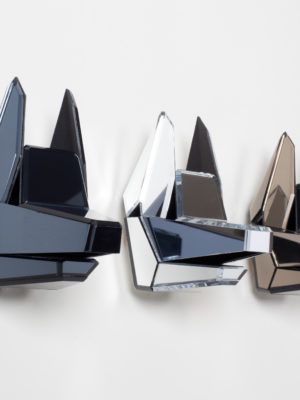
SM: It’s almost as if it’s some kind of semi-fiction we are talking about here, in that it is not purely imagined but is rather about existing things coming to life. Am I right?
AB: I would say yes and no. It´s both purely imagined aspects and existing things that catch me. For example, autobiographical situations or thoughts go in side by side with purely imaginary aspects. In my opinion, both parts get closer to each other.
Previously you were using the term ‘props’. May I ask you how you see this term? Because it´s normally used to lower an object’s value, I think. Is there a hierarchy for you when it comes to text and object? Or do they belong together?
SM: Regarding the use of the term ‘props’, let me clarify what I meant. By providing the object with a side order of fiction you can make it come to life. It’s like reverse engineering a movie prop – you create the story for the sake of the object. I wouldn’t say there is a hierarchy when it comes to text and object. I’ve been in situations where I’ve started writing a story then made an object and then ended up going back and changing parts of the story because I felt like the object required it.
AB: I looked through some of your work, and your pieces seem to work quite well in images and on social media platforms – in a fun, cosplay kind of way. Are the pieces mainly meant for images on such platforms and for your narrative there? Would you say that it is you in those images?
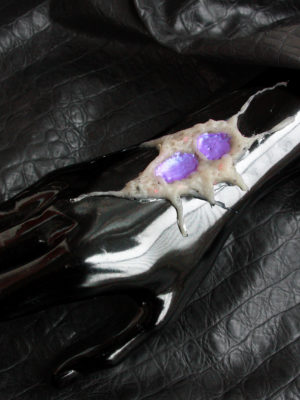
SM: I like the word ‘cosplay’. I actually used to go to a lot of conventions, and maybe this is the reason why I like so-called ‘props’ and wear them myself when I present them online. I feel like the pieces seem lifeless when presented on a white background, and the only way to change that is to give them a purpose – and in this case the purpose is to give me the feeling of having special abilities. I feel like I can be whoever I want in those pictures, but I would say it is a mixture between the real me and a fictional character. It’s a lot about that freedom you have when it comes to how you present yourself online.
I guess we can agree that sci-fi is probably a major interest for us both because it’s much more object-driven than other genres. Objects in sci-fi act like arguments – they place the narrative in another time period or ‘out of this world’ environment.
AB: Of course, the object-driven part of sci-fi is interesting, but I’m more interested in how fiction somehow relates to ‘now’, ‘here’, ‘us’, on this planet.
For example, I think it is fascinating that some of the objects shown as examples of top-notch futuristic design in sci-fi movies from the eighties and nineties have quickly become items we use daily today. We are living parts of those sci-fi narratives right now.
Some of the main topics in sci-fi now are the destruction of the planet, society at its end, and other dystopian visions of the future. This seems to fit with the prognoses of everyday newsflashes. I think it’s weird that the narration of fiction and reality get closer to each other. There used to be different narratives of the future in sci-fi, but it has now narrowed down to a dystopian/apocalyptic path. Maybe it´s because drama sells better; it’s hopefully not because no-one can seem to imagine a bright colourful future anymore.
My interest in a fictional genre or setting is in where fiction and ‘reality’ almost overlap, where you can not exactly say which is which.
With some of my jewellery, I use films and stories from the present or my childhood to talk about things that interest me. I analyse the characters a lot – the hero, the villain, the fool, the clown, the loon, etc. Not only as one-sided stereotypes but also in their different representations throughout history and different narratives.
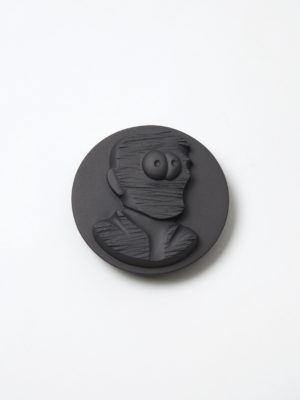
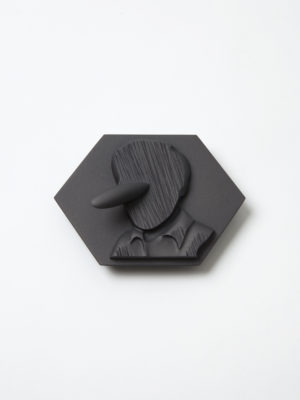
‘I’ve got a fountain on my wrist’ then I can go on imagine what an actual wrist fountain would look like. This could also be considered a type of fiction since I was combining things I knew with things I imagined.’
SM: Talking about all these different characters, what immediately comes to mind for me are social media and our online personas. I feel that this is where we practise fiction today.
AB: I’d rather die than waste my time on presenting myself online. I’d rather make jewellery instead! No, just kidding. I quit being on social media platforms like Instagram after having a very shitty situation with the negative elements of it, alongside some other stuff that almost led me to quit everything in ‘jewelleryland’. My trust in these platforms is still not there yet. Not everything lies in your own hands and sometimes you can’t stop things happening, even if you need to. Don´t get me wrong, I’m not too pessimistic about this, I just decided for myself to quit social media or at least to take a much longer break. I think it´s a great thing and it has many options and tools to play with, but it also creates an info hunter/prey situation in that images work as bait for attention and likes, and shares are the measure of their quality. This sensationalisation of everything, no matter banal it is, only lasts for short moments, and I´m happy to not participate anymore. It gives me less stress.
I’m more interested in the meeting point between the real person and their online appearance; it sparks more questions for me.
It’s more interesting to me to look behind facades rather than to create them, which of course still always happens, but nevertheless I like the not-so-idealised human more. I’m attracted to the down-to-earth version more than the superhuman. Less vanity, less idealisation, less heroism, less fame, less artifice – not none of all of this, just less. In my work Jimmy´z, I use images of social media celebrities and kinda scratch away their serious profiles to find silly cartoon elements under the skin. And with the transparent Shield brooches, I´d rather see a character protected from outside influences.
Images are posted for a purpose or in service to some sort of efficiency and I prefer my pieces not be too exploited like this too much. I personally enjoy presenting myself, my pieces and fictions through the old-school format of the exhibition. There is more time for interaction, conversation, etc.
SM: You mentioned that the characters in your works have different roles. This is something I have not yet considered: whether or not my fictions need to portray characters in classic roles such as heroes and villains. Maybe you could provide me with a more specific example of characters in your work?
AB: I fell in love with old cartoon losers – Daffy Duck, Wile Coyote, Donald Duck, etc – because they never give up, even when the script is against their plans to succeed. I think this is a great metaphor to put into a piece of jewellery, don’t you?
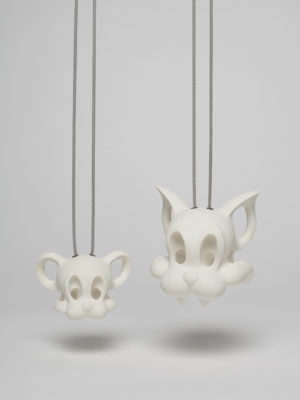
SM: I think its a great metaphor. Usually when I think about never giving up or, you know, this ‘zero to hero’ kind of storyline I think about rap music. It has all the metaphors for wearing jewellery in combination with turning nothing into something. Before I started to have an interest in fiction a lot of my works originated from song lyrics. I used memorable or outrageous metaphors from songs to imagine what the piece of jewellery described could look like if it actually existed. An example I used in my previous interview with current obsession was the sentence: ’I’ve got a fountain on my wrist’ then I can go on Imagine what an actual wrist fountain would look like. This could also be considered a type of fiction since I was combining things I knew with things I imagined.
AB: I think hip-hop’s ‘nothing into something’ or ‘zero to hero’ narrative is too often told, or perhaps only told, from the winners’ side – maybe in the way any kind of history is told by those that made it, giving only one side of the story. It’s a very capitalistic narration, very predetermined. It’s a story that has been agreed upon for too long.
I like the quieter stories from the other guys, about how they stay motivated when fame is not knocking at the doorstep. Maybe it’s a bit naïve, but I love metaphor because it empowers the character of the loser, because they stay motivated; even if the script never lets them succeed, they are still strong and ambitious. Like, it is as if the trying is the success, not the winning, which is always the promoted aim, the golden carrot or whatever.
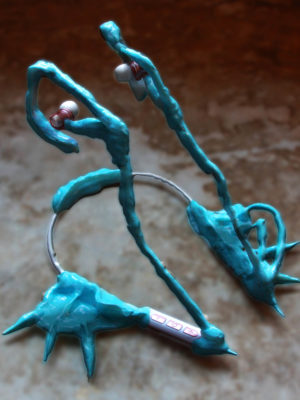
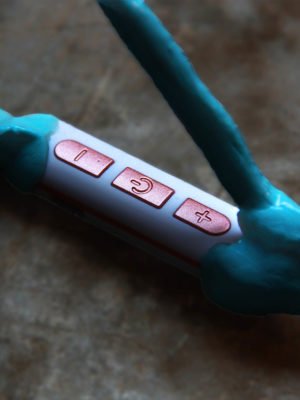
About the Author: Simon Marsiglia, born in Sweden, will be graduating at the Rietveld Academy from Design Department in 2020. He exhibited his work in the group exhibition Non-Stick Nostalgia: Y2K Retrofuturism in Contemporary Jewelry at the Museum of Arts and Design in New York. During Munich Jewellery Week you could see his work at Life Soup, Kreative Quartier, Halle 6, #74 on the map.
